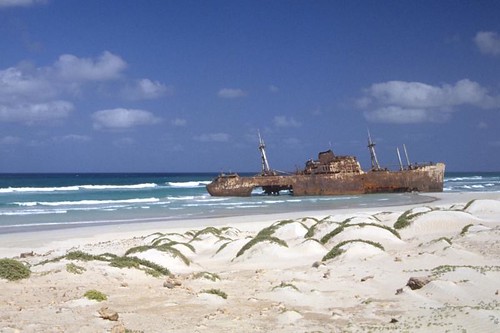
Wreck
Cape Verde is comprised of 10 volcanic islands and five islets off the coast of Senegal. The islands were first discovered by the Portuguese in the 15th century and were uninhabited at the time. They named it “Cape Verde” for its verdant landscape. Unfortunately, the islands are no longer as lush as perhaps they once were. But visitors, nevertheless, are still enchanted by Cape Verdes’ beautiful mountain scenery, deserted white beaches, and amazingly-clear blue waters.
Cape Verde’s archipelago of 15 islands and islets forms a crescent shape in the Atlantic Ocean. The main inhabited islands are Santo Antão, São Vicente, São Nicolau, Sal, Boa Vista, Santa Luzia, Maio, Santiago, Brava, and Fogo. Each of the islands has its own distinct character; Santiago is lush and lively; Sao Nicolau is characterized by its volcanic and mountainous terrain; Sal is sandy, salty, and fishing-oriented; Boa Vista is a famous scuba diving destination; Fogo Island is home to the active volcanic crater shaped like a half moon – the Pico do Fogo – which rises to a height of more than 9,280 feet; and São Vicente is known for its lively festivals, parties, and nightlife including the exuberant Carnival and traditional Baia das Gatas.
Overall, the islands have little plant life in the higher regions and coasts. The interior valleys, however, feature tropical vegetation. Wildlife on Cape Verde is limited to farm animals and several varieties of birds. The waters, though, abound with numerous fish species and whales, providing opportunities for underwater fishing and whale-watching.
The people in Cape Verde are mostly mixed Portuguese-African, with a minority of Europeans. Originally, workers were brought in from the African mainland to work the plantations set up by the Portuguese. Eventually, the Africans and Portuguese intermarried. Each island has developed its own customs and traditions. Roman Catholicism remains the dominant religion and Verdean Creole is the country’s official language.
Attractions
Cape Verde is best visited for its spectacular white sandy beaches. The islands with the best beaches are Santiago and Sal. Sao Nicolau is also notable for its black sand beaches. These beaches offer swimming, sunbathing, surfing, windsurfing, and sailing. Surfing is particularly popular in Sal where the waves are rough and enticing to advanced surfers. Boa Vista and Sal have a number of popular dive spots, as well as the best personnel and equipment. There are a number of shipwreck sites that can be explored and water temperatures are warm year-round.
In the interior of the islands, you’ll find a more lush landscape. The plant life on Brava, for example, is diverse and unique. Hiking into the interior of Brava also offers scenic views of the coasts from higher elevation plateaux. An even better hike or climb is the rugged coast of Santo Antão, which is one of the greener islands and dominated by forested hills, tropical flora, flat-bottomed valleys, and craters of extinct volcanoes. The highlight of Santo Antão is the Ribeira Grande Mountain, which takes a day to climb. The island of Fogo offers a great hike as well, featuring an active volcano.
For historic ruins, visit Cidade Velha in Praia which is the site of the first Portuguese settlement in Cape Verde. You’ll find the old Fort Real de San Felipe and other ruins, including the Pelourinho square, which used to serve as the center of slave trade on the islands. The fishing village of Tarrafal on the northwest end of Santiago features an old colonial prison where dissidents of Portuguese dictator, Salazar, were held during his reign in the 20th century. Mindelo on São Vicente has a line of old colonial buildings.
The best nightlife in Cape Verde is in the islands’ capital, Praia, and São Vicente which is famous for its Carnival and traditional Baia das Gatas Festival in August.
History
Cape Verde was discovered in 1460 by the Portuguese. The archipelago was uninhabited then. For 300 years, the islands enjoyed prosperity with its plantations and crops. Since the late 19th century, however, drought, crop failures, and famine have plagued the islands, though Cape Verde has regained its importance as a refueling stop for Atlantic ships. Cape Verde remained part of Portugal until it was granted independence in 1975.
Climate
The climate in Cape Verde is generally warm; temperatures average 75°F (24°C) throughout the year. The rainy season usually runs from July to November.


Comments